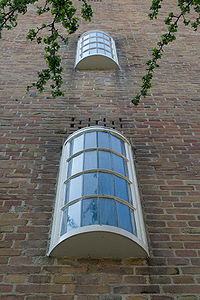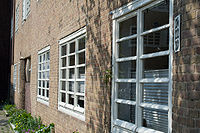
Amsterdam School
Encyclopedia





Expressionist architecture
Expressionist architecture was an architectural movement that developed in Europe during the first decades of the 20th century in parallel with the expressionist visual and performing arts....
, sometimes linked to German Brick Expressionism
Brick Expressionism
The term Brick Expressionism describes a specific variant of expressionist architecture that uses bricks, tiles or clinker bricks as the main visible building material...
.
In German Brick Expressionism important expressionist buildings are excluded, such as the famous Einstein Tower in Potsdam by Erich Mendelsohn
Erich Mendelsohn
Erich Mendelsohn was a Jewish German architect, known for his expressionist architecture in the 1920s, as well as for developing a dynamic functionalism in his projects for department stores and cinemas.-Early life:...
(white plaster) and the Philharmonie in Berlin by Hans Scharoun
Hans Scharoun
Bernhard Hans Henry Scharoun was a German architect best known for designing the Berlin Philharmonic concert hall and the in Löbau, Saxony. He was an important exponent of Organic architecture....
(yellow facade). These two buildings are related to international Expressionist architecture. In the international movement the expressive language of architectural form is relevant and different materials and colours are existing. Further examples of international Expressionist architecture are: the P.L.Takstraat Housing Estate in Amsterdam by Piet Kramer
Piet Kramer
Pieter Lodewijk Kramer was a Dutch architect, one of the most important architects of the Amsterdam School ....
(red brick), the Goetheanum in Dornach by Rudolf Steiner
Rudolf Steiner
Rudolf Joseph Lorenz Steiner was an Austrian philosopher, social reformer, architect, and esotericist. He gained initial recognition as a literary critic and cultural philosopher...
(grey concrete) and the Casa Milà in Barcelona by Antoni Gaudi
Antoni Gaudí
Antoni Gaudí i Cornet was a Spanish Catalan architect and figurehead of Catalan Modernism. Gaudí's works reflect his highly individual and distinctive style and are largely concentrated in the Catalan capital of Barcelona, notably his magnum opus, the Sagrada Família.Much of Gaudí's work was...
(grey stone). Antoni Gaudi is often seen as the father of international Expressionist architecture. It's interesting to compare these Expressionist buildings to the work of contemporary architects like Frank Gehry
Frank Gehry
Frank Owen Gehry, is a Canadian American Pritzker Prize-winning architect based in Los Angeles, California.His buildings, including his private residence, have become tourist attractions...
and Santiago Calatrava
Santiago Calatrava
Santiago Calatrava Valls is a Spanish architect, sculptor and structural engineer whose principal office is in Zürich, Switzerland. Classed now among the elite designers of the world, he has offices in Zürich, Paris, Valencia, and New York City....
.
Buildings of the Amsterdam School are characterized by brick construction with complicated masonry with a rounded or organic appearance, relatively traditional massing, and the integration of an elaborate scheme of building elements inside and out: decorative masonry, art glass, wrought ironwork, spires or "ladder" windows (with horizontal bars), and integrated architectural sculpture. The aim was to create a total architectural experience, interior and exterior.
Imbued with socialist
Socialism
Socialism is an economic system characterized by social ownership of the means of production and cooperative management of the economy; or a political philosophy advocating such a system. "Social ownership" may refer to any one of, or a combination of, the following: cooperative enterprises,...
ideals, the Amsterdam School style was often applied to working-class housing estates, local institutions and schools. For many Dutch towns Hendrik Berlage
Hendrik Petrus Berlage
thumb|120px|left|BerlageHendrik Petrus Berlage, Amsterdam, 21 February 1856 — The Hague 12 August 1934, was a prominent Dutch architect.-Overview:...
designed the new urban schemes, while the architects of the Amsterdam School were responsible for the buildings. With regard to the architectural style, Michel de Klerk
Michel de Klerk
Michel de Klerk was a Dutch architect.He was one of the founding architects of the movement Amsterdam School. Early in his career he worked for other architects, including Eduard Cuypers. Of his many outstanding designs, very few have actually been built...
had a different vision than Berlage. In the magazine "Bouwkundig Weekblad 45/1916" Michel de Klerk criticized Berlage's recent buildings in the style of Dutch Traditionalism
Traditionalist School (architecture)
In Dutch architecture, Traditionalism or the Traditionalist School was a reaction against the Functionalism and the Expressionism of the Amsterdam School, and a 'return' to rural and national architectural styles and traditions, with tidy brickwork, minimal decoration and 'honest' materials.It...
. In this context, the Stock Exchange by Berlage of 1905 can be seen as the starting point of Traditionalist architecture. From 1920 to 1930, Traditionalism
Traditionalist School (architecture)
In Dutch architecture, Traditionalism or the Traditionalist School was a reaction against the Functionalism and the Expressionism of the Amsterdam School, and a 'return' to rural and national architectural styles and traditions, with tidy brickwork, minimal decoration and 'honest' materials.It...
, Expressionism
Expressionist architecture
Expressionist architecture was an architectural movement that developed in Europe during the first decades of the 20th century in parallel with the expressionist visual and performing arts....
, De Stijl
De Stijl
De Stijl , propagating the group's theories. Next to van Doesburg, the group's principal members were the painters Piet Mondrian , Vilmos Huszár , and Bart van der Leck , and the architects Gerrit Rietveld , Robert van 't Hoff , and J.J.P. Oud...
, Constructivism
Constructivist architecture
Constructivist architecture was a form of modern architecture that flourished in the Soviet Union in the 1920s and early 1930s. It combined advanced technology and engineering with an avowedly Communist social purpose. Although it was divided into several competing factions, the movement produced...
and Rationalism
New Objectivity (architecture)
The New Objectivity is a name often given to the Modern architecture that emerged in Europe, primarily German-speaking Europe, in the 1920s and 30s. It is also frequently called Neues Bauen...
, were parallel movements in The Netherlands. The Expressionism of the Amsterdam School was the most successful style of the 1920s. For many foreign architects, Amsterdam was the "Mecca" for new town extensions. But the Traditionalist movement lasted longer, until the 1950s, thanks to the so-called Delft School, represented by Martinus Grampré Molière at the Delft University of Technology. In the 1960s the Rationalist movement was dominant. In a well-known speech, the Dutch Rationalist Willem van Tijen declared the Amsterdam School a warning example for architects (published in Forum 9/1960-61). After the death of Piet Kramer
Piet Kramer
Pieter Lodewijk Kramer was a Dutch architect, one of the most important architects of the Amsterdam School ....
in 1961, no architectural institution or museum was interested in his Expressionist work. For that reason, all his drawings, blueprints and models were burnt.
The Amsterdam School had its origins in the office of architect Eduard Cuypers
Eduard Cuypers
Eduard Cuypers was a Dutch architect.Cuypers was trained in the architectural practice of his uncle P.J.H. Cuypers and in 1881 set up his own office in Amsterdam. His good contacts with businessmen earned him commissions for offices, shops and houses...
in Amsterdam. Although Cuypers wasn't a progressive architect himself, he gave his employees plenty of opportunity to develop. The three leaders of the Amsterdam School Michel de Klerk
Michel de Klerk
Michel de Klerk was a Dutch architect.He was one of the founding architects of the movement Amsterdam School. Early in his career he worked for other architects, including Eduard Cuypers. Of his many outstanding designs, very few have actually been built...
, Johan van der Mey
Johan van der Mey
Johan Melchior van der Mey was a Dutch architect best known for the landmark Scheepvaarthuis building in Amsterdam located at Prins Hendrikkade, 1012....
and Piet Kramer
Piet Kramer
Pieter Lodewijk Kramer was a Dutch architect, one of the most important architects of the Amsterdam School ....
all worked for Cuypers until about 1910. Impetus for the movement also came from the city. In 1905 Amsterdam was the first city to establish a building code, and the city hired Johan van der Mey afterwards, in the special position as "Aesthetic Advisor", to bring artistic unity and vision to its built environment.
Van der Mey's major commission, the 1912 cooperative-commercial Scheepvaarthuis (Shipping House), is considered the starting point of the movement, and the three of them collaborated on that building. The Scheepvaarthuis is the prototype for later Amsterdam School work. The most important examples are obviously found in Amsterdam
Amsterdam
Amsterdam is the largest city and the capital of the Netherlands. The current position of Amsterdam as capital city of the Kingdom of the Netherlands is governed by the constitution of August 24, 1815 and its successors. Amsterdam has a population of 783,364 within city limits, an urban population...
, the single most important of which probably is Het Schip
Het Schip
Het Schip is an apartment building in the Spaarndammerbuurt district of Amsterdam, built in the architectural style of the Amsterdam School of Expressionist architecture. It is the single most important example of this style of architecture, using the Brick Expressionism version.The building was...
, designed by de Klerk. The movement and its followers played an important role in Berlage's overall plans for the expansion of Amsterdam.

Berend Tobia Boeyinga
Berend Tobia Boeyinga was a Dutch architect noted for his Calvinist church buildings and as a practicing member of the Amsterdam School....
, P. H. Endt, H. Th. Wijdeveld, J. F. Staal, C. J. Blaauw, and P. L. Marnette. The journal Wendingen
Wendingen
Wendingen was an art magazine that appeared from 1918 to 1932. It was a monthly publication aimed at architects and interior designers. The booklet was published by Amsterdam publisher Hooge Brug and it was a mouthpiece for the architect association Architectura et Amicitia. . The chief editor was...
("Windings" or "Changes"), published between 1918 and 1931, was considered the magazine of the Amsterdam School.
After De Klerk died in 1923 the style lost most of its importance. The De Bijenkorf department-store in the Hague
The Hague
The Hague is the capital city of the province of South Holland in the Netherlands. With a population of 500,000 inhabitants , it is the third largest city of the Netherlands, after Amsterdam and Rotterdam...
by Piet Kramer of 1926 is considered to be the last example of "classic" Amsterdam School expressionism. Moderate variants of the style survived until the Second World War, for example in Protestant church architecture.
External links
- Archimon
- The Amsterdam School museum, located in Het Schip
- Amsterdamse School (in Dutch)
- Amsterdam School of architecture outline and pictures
- Guided tour + photographs

